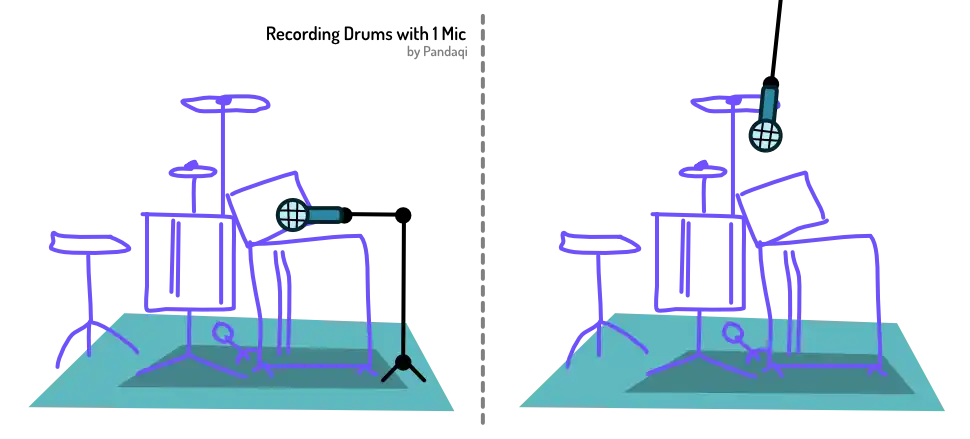Drums
Drums are the third instrument I suggest you learn (well). They are the silent hero of most songs. Without them, the whole song falls apart or sounds lifeless. But … nobody ever listens to a song and notices the drums. They give rhythm and groove, but then get out of the way so other instruments can shine.
Have you ever wondered why a (classic) drum set is the way it is? It has this really low kick drum. Then some semi-low parts, like the snare and toms. And then really high and crisp hi-hats and crashes.
This is a blanket around the other instruments. Piano and guitar live in the midrange. Our voice lives in the midrange. Almost all instruments live there.
The drum provides the lowest range and the highest range. It fills in the gaps—the area where not much other sound appears. The lowest range adds “oomph” and rhythm. The highest range adds excitement, energy and fullness.
Many songs add simple shakers or tambourines during the chorus. You can record these by simply waving them in front of any microphone. Very easy. But their high frequencies add lots of excitement to the track!
What does this mean?
Firstly, take this into account when arranging. It’s often wise to start with drum. Lay down a solid drum recording, use that as the cue mix for any other recordings. This prevents you from recording other instruments for the lowest or highest frequencies. Now you already know those are filled by the drums and you don’t need (much) more.
Secondly, this means recording drums with a single microphone is somewhat impossible. It has these two very different ranges. Unless you manage to balance and capture them perfectly with that one recording, there’s no saving it later. If you realize the low part needs to be much louder at some later point—tough luck. (Unless you want to spend hours being a mixing wizard.)
If you still want a single microphone capture, point one at the center. This mic can be very close: barely floating above the kick drum. Alternatively, hang one from the ceiling above the drum set. Above the player but slightly in front of them. (If the drummer is singing at the same time, as some drummers do during live performances, such a floating mic will be used for the voice instead.)

Otherwise, use many microphones to capture a drum. Preferably one for each unique part. If that’s not possible, try to capture multiple pieces within the same range on one microphone.
The advantage of a percussive instrument, is that you can put the microphones really close and it will be fine. They don’t need much air or distance. In fact, that’ll just make the sound washed out. Drums are loud—their echo will be loud as well.
The most important thing to get right are not the pitches, but the hits. The transients. Don’t start playing immediately when the recording starts—you’ll miss that first hit. Similarly, don’t record too soft or too compressed, as then every hit starts to sound the same. There would be no clear peaks or beats, which is a deadly sin for drumming.
Because they are so loud, they might clip your microphones … even on their lowest volumes! That’s why most microphones have a “drum pad” or “-10 dB pad” built-in. Turn it on, and the input of the microphone is lowered in volume before it even reaches the audio interface. This is often necessary to record loud drums.
My recommendation
Honestly, recording a physical drum is very expensive and a lot of work. For those like me, it’s not possible and not worth it.
Instead, I’d recommend an electric drum. You circumvent issues with microphones and recording: it’s just a direct line into your interface. It’s not as noisy and doesn’t need as much tuning/replacement as a physical drum.
But it still allows you to get realistic, lively, groovy drum patterns. Something that’s not possible by tapping notes on a MIDI keyboard. The drum is designed the way it is for a reason. If you learn to play it, even just a bit, you’ll understand rhythm and frequencies much better.
You’ll find good and fun patterns to record more easily. And those bring more life to your recordings than the tenth double of the same guitar.
I frankly didn’t want this to be true. I told myself it was “fine” to play drums with my keyboard or to improvise my way around it. But it’s not. It sounds so much worse, and makes it so much harder to really understand rhythm and apply it well. Once I got serious about drumming, my feeling for tempo and groove improved immensely. And, by default, all my recordings improved.
As you notice, this chapter is much shorter than the others. Now you know why. My experience with drums and properly recording them is new and recent, so I can’t say much more.
If an e-drum is too expensive, you can start with cheap percussive tools like shakers, tambourines or maybe a cheap cajon. They’ll set you on the right path. And even an egg shaker worth 1 euro can turn a dull chorus into a professional one.
Want to support me?
Buy one of my projects. You get something nice, I get something nice.
Donate through a popular platform using the link below.
Simply giving feedback or spreading the word is also worth a lot.